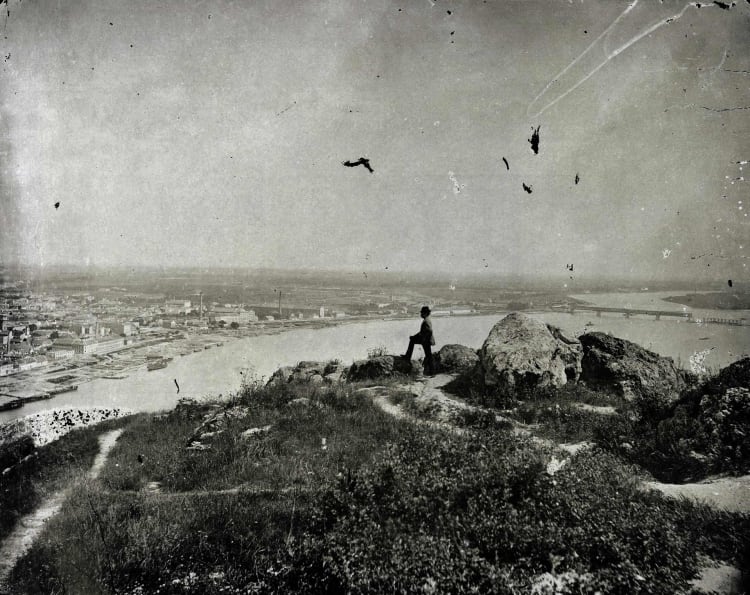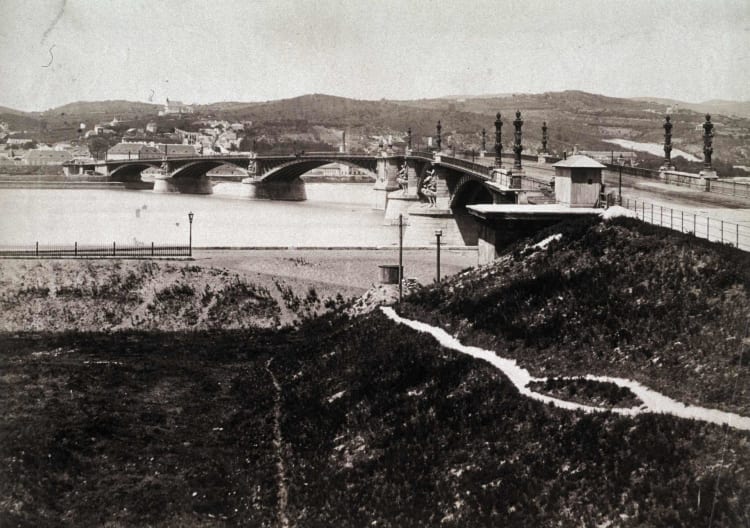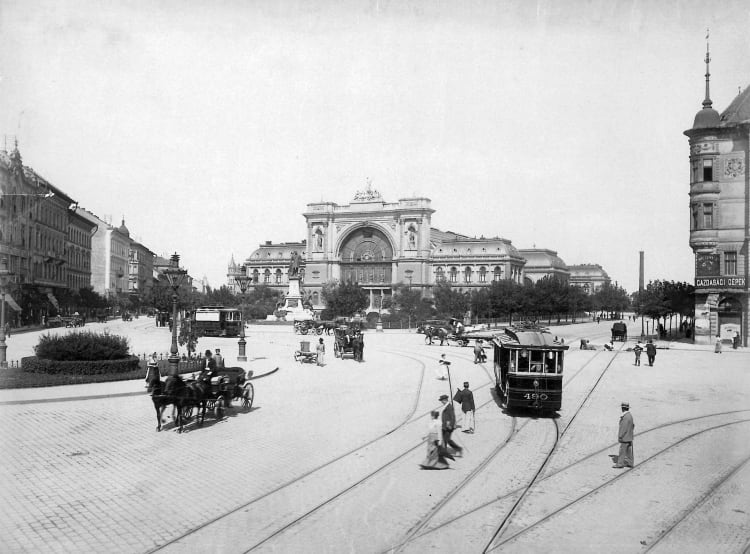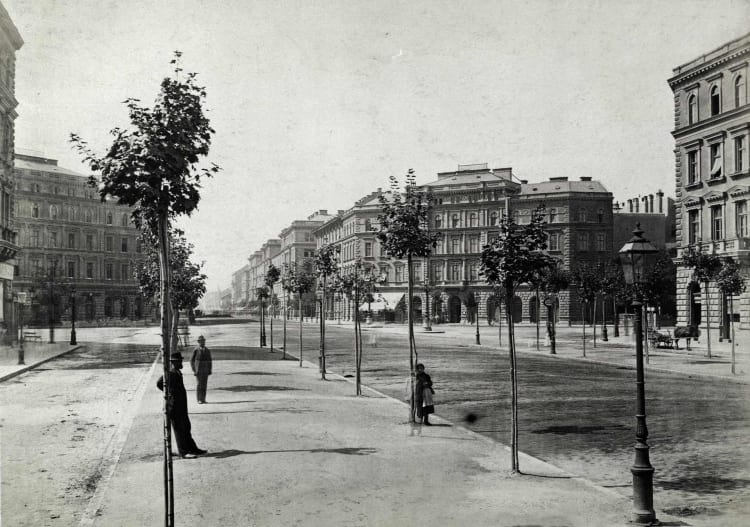
The Birth of Budapest
The union of Pest, Buda and Óbuda was first proposed by Count István Széchenyi at the beginning of the 1830s.
Széchenyi was not only instrumental in establishing the Hungarian Academy of Sciences, and the National Casino, but was also involved in the introduction of horse racing to the capital, and of steamboats on the Danube and Lake Balaton. Perhaps his most significant contribution, however, was the building of the Chain Bridge, which was the first permanent link between Pest and Buda, the eastern and western sides of the country.
 Gellért Hill, 1900 (source: Fortepan / Budapest City Archives / Photos of György Klösz)
Gellért Hill, 1900 (source: Fortepan / Budapest City Archives / Photos of György Klösz)
The history of Pest goes back to Roman times, its residents at the time having built a fortress on what is today March 15th Square near the foot of Elisabeth Bridge. After a long period of Turkish rule, from the end of the 17th century onwards, many Catholic Germans found a home in Pest. Over the next century, Hungarians, Serbs, Jews and, to a lesser extent, Greeks, Aromanians and Slovaks also settled here. Pest became an important commercial centre thanks to Greek, Serbian and Jewish merchants. The city’s population grew rapidly: while in 1851 Pest had 43,000 inhabitants, three decades later it ballooned to more than 350,000. Pest remained a multi-cultural haven: according to the census in 1881, among others there were 195,912 Hungarians, 118,607 Germans, 21,237 Slovaks, 3,586 Czechs, 2,441 Poles, 1,658 Serbs and Croats, 706 Italians, 386 Romanians, 299 French, 101 English, 57 Ruthenians, 48 Greeks, 35 Russians, 32 Spaniards, 25 Gipsies, 19 Bulgarians, 16 Dutch, 11 Turks and 10 Armenians living in the city. *
 Margaret Bridge, 1883 (source: Fortepan / Fortepan / Album050)
Margaret Bridge, 1883 (source: Fortepan / Fortepan / Album050)
During the Middle Ages, Buda was both the royal seat and the capital of Hungary. During Turkish rule its population dwindled, and new settlers were mostly German and Serbian. In the 19th century the town was mostly an administrative centre headquartering several important institutions, but it also gained a reputation for its wine production.
Óbuda has been settled since prehistoric times. It was both a transport hub and a river crossing. In Roman times it was the site of a settlement called Aquincum in the province of Pannonia. The ruins of Aquincum can still be visited in today’s Óbuda. After the Turkish occupation, it was populated by migrants from Moravia and Austria. According to accounts from 1854, out of a total of 50,127 inhabitants in Óbuda and Buda, 27,939 were German, 7,555 Hungarian, 4,976 Jewish, 1,307 Slovak, 1,180 Serbian, 46 Italian and 16 were Swiss.** The area was primarily characterised by agricultural activity, in particular viticulture and winemaking.
 City Park, 1900 (source: Fortepan / Budapest City Archives / Photos of György Klösz)
City Park, 1900 (source: Fortepan / Budapest City Archives / Photos of György Klösz)
Although Széchenyi first proposed to unite these three towns, it was Count Gyula Andrássy who succeeded in doing so after he proposed the creation of the necessary legal framework in 1868. The three towns became one on 1 January 1873, and the new city was named Budapest.
At the time, on the hilly Buda side, it consisted of the 1st District with Krisztinaváros, the Castle, Tabán and Kelenföld, and towards the North, the 2nd District, called Víziváros, and the 3rd District, Óbuda. On the flatlands of Pest, the districts were as follows: IV. Belváros, V. Lipótváros, VI. Terézváros, VII. Erzsébetváros, VIII. Józsefváros, IX. Ferencváros and X. Kőbánya.
 Eastern Railway Station in Budapest, 1903 (source: Fortepan / Noémi Saly)
Eastern Railway Station in Budapest, 1903 (source: Fortepan / Noémi Saly)
Over time, the capital has expanded significantly and the number of districts has grown to 23. While their numbering and layout have changed, today every district offers interesting and diverse cultural delights worth exploring.
* József Kőrösi: The Ethnic Status of Budapest and its Hungarian-isation according to the results of the census of 1881. Hungarian Academy of Sciences, 1882
** The Chronicle of Budapest - From the Beginning to Today (Edited by István Bart), Corvina Publishing, 200
-------------
See also: Birth of a Metropolis
-------------
The Alrite speech recognation (speech-to-text) program helped to write the publication.
Photo: Liberty Bridge, around 1900 (source: Fortepan / József Plohn)
Szenvedélyesen szeretjük a kultúrát, a művészeteket és a stratégiai gondolkodást. Ez ingyen van. A lapkiadás és az online magazin működtetése azonban pénzbe kerül. Kérjük, ha teheti, támogassa az Art is Business hiánypótló munkáját!
2025 decemberében jelentetjük meg A mecenatúra 125 éve 1900-tól napjainkig című kiadványunkat.
Támogassa a kiadvány létrejöttét, legyen Ön is mecénás!

 Andrássy Street near to Octogon square, around 1900 (source: Fortepan / Budapest City Archives / Photos of György Klösz)
Andrássy Street near to Octogon square, around 1900 (source: Fortepan / Budapest City Archives / Photos of György Klösz)


